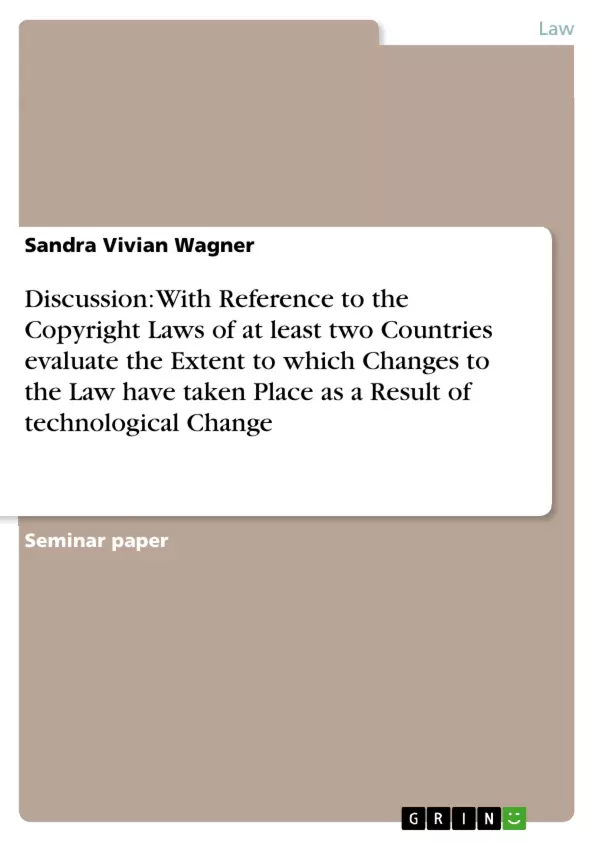This paper tries to examine the impact of technological change and thus asks, in how far copyright laws have developed as a direct answer to technological inventions and which other factors supported or delayed its development. After a short presentation of the concept of copyright, it is argued that worldwide technological change was and still is one of the most important factors influencing the development of copyright laws. However, it is also shown that this impact has not always been the same. This paper identifies four distinguishable ‘epochs’ which reflect different impacts of technology on the development of copyright law and it can be seen that basically the following ‘epochs’ can be found in various jurisdictions:
1. from 1445-1500 technological change was the initial drive for copyright law;
2. from 1500-1700 the stabilisation of political power through censorship determined copyright law;
3. from 1700-1886 technological progress is again in the centre of copyright developments and
4. from 1886-today technological progress is still highly influential, but the aim of international uniformity and economic considerations are of equally strong influence.
Having a closer look on these four ‘epochs’ , it is also shown that they cannot be seen as fixed, as not all countries fit nicely into this scheme.
Inhaltsverzeichnis (Table of Contents)
- I. INTRODUCTION.
- II. ELABORATION.
- 1. The Concept of Copyright.
- 2. A Journey through Copyright History
- (a) 1st Epoch': 1445-1500.
- (b) 2nd Epoch': 1500-1700.
- (c) 3rd Epoch': 1700-1886
- (1) First Modern Copyright Laws...
- (2) Photography
- (3) Outcome.
- (d) 4th Epoch': 1886-today
- (1) National Uniformity
- (2) International Uniformity.
- (3) Technological Progress.
- (i) Radio..
- (ii) Sound Recordings and Film.
- (iii) Xerography
- (iv) Computers, Internet and Digitalisation
- (4) Censorship..
- (5) Conclusion
- III. CONCLUSION.
Zielsetzung und Themenschwerpunkte (Objectives and Key Themes)
This paper examines the impact of technological change on the development of copyright law. It aims to assess to what extent copyright laws have evolved as a direct response to technological inventions and to identify other influential factors that have contributed to or hindered their development. The paper argues that technological change has been a major driving force behind copyright law, although its influence has not always been consistent.
- The historical development of copyright law.
- The influence of technological change on copyright law.
- The impact of various technological inventions on copyright law, including printing, photography, film, photocopying, sound recording, and digitalisation.
- The role of other influential factors, such as political power, censorship, international uniformity, and economic considerations.
- The distinction between four distinguishable 'epochs' reflecting different impacts of technology on copyright law.
Zusammenfassung der Kapitel (Chapter Summaries)
The first chapter introduces the paper's objective and outlines the argument that technological change has been a significant factor in the development of copyright law. It also proposes four distinct 'epochs' that reflect different levels of technological influence. The second chapter begins with a definition of copyright and its legal basis. It then analyzes the historical development of copyright law, focusing on the UK and the US, with comparisons to other jurisdictions. The analysis examines how copyright law has been shaped by various technological advancements, from printing and photography to sound recording and digitalisation.
Schlüsselwörter (Keywords)
Copyright law, technological change, intellectual property, historical development, epochs, printing, photography, film, photocopying, sound recording, digitalisation, international uniformity, economic considerations, censorship, legal basis, UK, US, comparative jurisdictions.
- Arbeit zitieren
- Sandra Vivian Wagner (Autor:in), 2004, Discussion: With Reference to the Copyright Laws of at least two Countries evaluate the Extent to which Changes to the Law have taken Place as a Result of technological Change, München, GRIN Verlag, https://www.grin.com/document/61017



